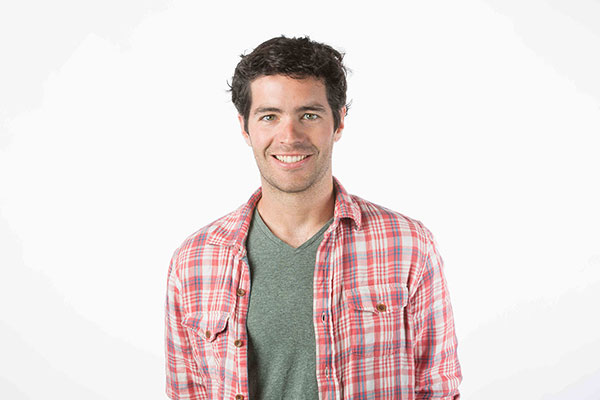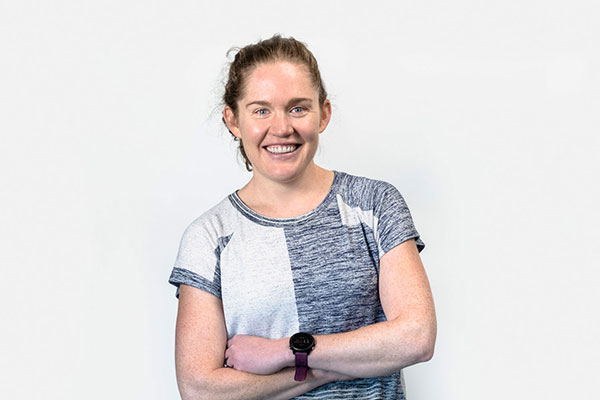HOW CAN WE SCIENTIFICALLY EVALUATE PERFORMANCE FIT?
By  Dan Feeney
Dan Feeney  Kate harrison
Kate harrison
Follow on ![]() @Dfeeney31 and @running_geek
@Dfeeney31 and @running_geek

Gear that fits better should provide a performance advantage. Our lab is focused on 1) identifying the movements that are sensitive to enhanced fit, 2) quantifying the improvements due to our configurations, and 3) driving new ways to improve fit and performance.
Quick takes
- We have published multiple preprints, papers, and conference presentations scientifically validating our approach to testing how performance improves due to fit.
- We quantify the benefits of performance fit in three main areas: Endurance & Health, Agility & Speed, and Power & Precision.
- Our lab uses the results from our validation studies to test products that are going to market to ensure that what reaches you enhances your performance.

Dan’s Take
Peak performance requires years of dedicated work but can only be attained once you layer in the last set of marginal gains. In some cases, there is low-hanging fruit that improves athlete performance simply by changing gear. Cyclists pay thousands of dollars for wheels that save them a few watts, runners buy racing shoes that may only last one race to shave a few seconds off their time, and golfers regularly purchase the latest and greatest drivers to gain a few extra yards on their drive distance. Improved fit of footwear can immediately confer a competitive advantage, but- until recently- fit was only associated with comfort. Recent research unequivocally demonstrates that fit also improves performance. We are focused on researching which aspects of performance are improved by fit and we test products heading to market to ensure they live up to the theory.

Kate’s Take
Studying fit and performance requires a fair amount of creativity. Shoe uppers have not been a focus of research in the footwear community, so we have a blank slate on which to work. This allows us a lot of room to explore (and also many dead ends to find!). Athletes qualitatively describe what they feel is a good fit – “lock down”, “no heel lift”, “wiggle room”. We translate this qualitative feedback to identify what we need to quantitatively measure in the shoe and see how this translates to performance to optimize fit.

BOA’s take
We are pioneering the science of fit. Most of the focus in footwear development and research has been directed on midsole and outsole characteristics, while the upper is often treated as a billboard. Despite great strides regarding the bottom package, including better grip, energy return, and stability, little is known about how to build the best shoe uppers to allow athletes to take full advantage of the technology in the mid and outsole. Since we are starting from square one, our priority is to define good fit, and how it should influence athlete performance. The next step is to validate the effects of advanced upper design on performance. And finally, use our learnings to drive innovation in future concept design.

Research on the topic
The ideal fit can vary dramatically based on your activity of choice. The ideal marathon racing shoe has a bit of space around the foot to accommodate swelling, while any excess room in a soccer (football) cleat is highly undesirable by players.
Since ideal fit differs depending on your goals, we test fit in relation to three main benefits: Agility & Speed, Endurance & Health, and Power & Precision. While an activity may have a primary association with one of these benefits, many activities will have fit profiles that borrow from two or all three of these categories. Most court sports emphasize Agility & Speed so athletes can change direction quickly. For shoes where Power & Precision is of utmost importance, athletes need to direct force consistently and accurately, making the most of an athlete’s power. Every athlete wants to move efficiently whether they are running, skiing, or cycling, so optimizing fit for Endurance requires finding a balance between connection, flexibility, and freedom for the foot. Lastly- but most importantly- every athlete hates missing time in their sport, so can better fitting equipment lead to a lower risk of injury?
We see three tangible areas where fit impacts these aspects of performance. First, better fitting shoes connect the foot more securely to the midsole so your foot will not slide around, meaning you can reduce impact simply with better fit. Secondly, consistent pressure across the top of the foot allows for better proprioception, meaning athletes can direct force more effectively, whether they are running, cutting, or riding. Taken together, shoe uppers help prevent movement beyond the capabilities of our musculoskeletal system (think: rolled ankles), while allowing freedom and flexibility to cut, jump, run, or ride to your limits (see our article on snowboard boots).
Of course, these theories are promising, but we need to prove them to gain the trust of the world’s top athletes and best brands. Last year, we completed a large-scale study demonstrating that our Performance Fit configurations can lead to four primary improvements within Agility & Speed.
- Faster time to change direction
- Less mechanical work used to execute high intensity drills (greater efficiency)
- Greater power generation
- More motion and force produced in the direction an athlete desires to move, and less going towards other directions (i.e. less wasted movement)

How we test
Our lab is focused on leveraging our findings for products that will hit the market, so how do we collect and use this data? Once we identify the benefit(s) most important to a given segment, we select movements athletes routinely perform to excel in their sport (for example, rapid lateral cutting in court sports). Based on the benefits and movements, we then need to make sure we have the right equipment to collect data and assess performance. We’ll test out these measurements in what we call Protocol studies, to make sure we can reliably detect the performance metrics we are looking to improve.
Once we have our testing protocol defined, we’ll move into a pilot study (10-20 participants) to test BOA configurations against best in class product on the market. At this point, there are two possible outcomes: 1) if we observe promising results, we move forward into a full-scale validation study with a third party research group to gain the utmost confidence in the efficacy of our product, or 2) if the pilot results don’t live up to our high expectations, we will go back to the drawing board to iterate on our ideas until we arrive at the one that will deliver on our promise of improved performance.
Once we complete a large-scale validation study demonstrating that our Performance Fit configurations provide a benefit, we know which variables can be impacted by improved fit and what design characteristics provide the best results. However, shoe models are constantly evolving. So, our work doesn’t end with these validation studies. The next step is to put products that we are in developing with our Brand Partners into our Performance Test process. These are one-week long, 5-6 person tests where we replicate the movements from our validation study on a small subset of 2-3 potential product configurations. By using the same movements and measurements that were validated in the full-scale study, we can see if the product under development is living up to the standard of improvement we expect.
In addition to our validation study in Agility & Speed, we have completed pilot studies in Endurance & Health and Power & Precision that are leading to larger scale validation studies. This enables us to test the majority of our product segments in the lab to ensure product that hits the market delivers a meaningful benefit.
When we worked with Saucony to develop the Saucony Switchback 2, we took learnings from our Agility & Speed validation study and early work in Endurance & Health (not yet published) to design a better-fitting and better performing shoe. We put 6 high-level runners through our laboratory testing, which compared the Saucony Switchback 2 to its predecessor in both Agility and Endurance. To test agility movements in a trail running shoe, we have athletes rapidly cutting, just like they may have to on a trail, across force plates embedded in the floor of our lab. Next, the runners hop onto the treadmill for 45 minutes at 80-85% of their maximal heart rate while we measure the forces they produce while running. We then put them through the same agility movements they completed at the beginning of the session, looking for changes in their performance. Based on this test, we saw the Saucony Switchback 2 allowed for improved agility performance after the run and a reduction of 3-5% in vertical loading rate while running the same speed, which implies the athletes were running with lower musculoskeletal loading despite running the same speed!

Saucony Switchback 2
What does this mean for the retailer?
The constant updates of footwear may seem tricky to keep up with –but take solace in the fact that footwear companies make each update for a reason. It's worth taking the time to learn what new technologies offer so you can match customers with the right products that will help them achieve their goals. At BOA, considerable time and investment is put in to ensuring every product we make delivers a fit that will enable an athlete to perform their best. Would your customer be interested in improving their agility, generating more power, and reducing their risk of injury?
What does this mean for the athlete?
Whether you are just getting into a new sport, or are a pro with decades of experience, there is always something new around the corner that may change the game for you. Updates may seem trivial from season to season but taking a minute to Google footwear from the 1970s in your sport will present a stark record of how that progress adds up. Investing the time to educate yourself about new products may allow you to take advantage of tech that will give you an edge. One of the best ways to keep up is to drop by your local retailers – it's their job to stay on top of each season’s advancements and understand who could benefit.
We can be found on Twitter @Dfeeney31 and @running_geek.